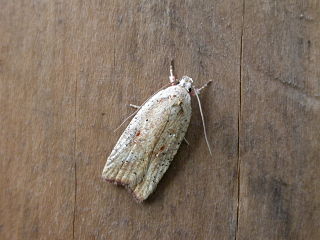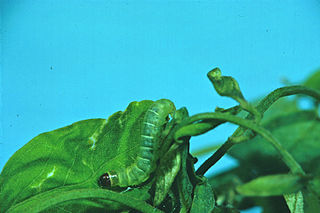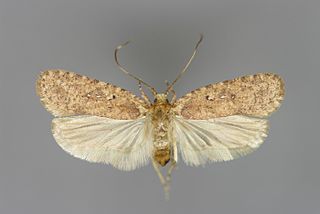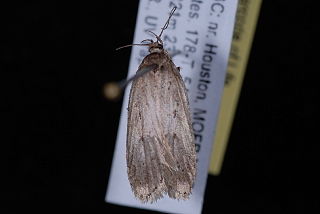
The hemlock moth, also known as the defoliating hemlock moth or poison hemlock moth, is a nocturnal moth species of the family Depressariidae. Of Palaearctic origin, it was first found in North America in 1973 when it was accidentally introduced. The moth is now widespread throughout the northern half of the United States, southern Canada, northern Europe, and, more recently, New Zealand and Australia. The larval form grows to around 10 mm, while the adults wingspan is between 17 mm and 19 mm.

The gorse tip moth is a smallish moth species of the family Depressariidae.

Agonopterix robiniella, the four-dotted agonopterix moth or locust leaf roller, is a moth of the family Depressariidae. It is found in North America, where it has been recorded to appear in places from Nova Scotia to Georgia, west to Oklahoma, north to Illinois, Michigan and southern Ontario.

Agonopterix heracliana is a moth of the family Depressariidae. It is found in most of Europe, North Africa, the Near East, and the eastern part of the Palearctic realm.

Thelma's agonopterix moth is a moth of the family Depressariidae. It is found in North America from New England to South Carolina, west to Kentucky and Illinois, north to Michigan and southern Ontario.

Agonopterix is a moth genus of the superfamily Gelechioidea. It is placed in the family Depressariidae, which was often – particularly in older treatments – considered a subfamily of the Oecophoridae or included in the Elachistidae.

Agonopterix canadensis, the Canadian agonopterix, is a moth of the family Depressariidae. It is found from the north-eastern United States and southern Canada, south through the Rocky Mountains to Colorado, the Basin Range and the mountains of central California and Nevada.

Agonopterix clemensella is a moth of the family Depressariidae. It is found in eastern North America, where it has been recorded from Arkansas, Illinois, Indiana, Kentucky, Maine, Michigan, Minnesota, Mississippi, Missouri, Ohio, Oklahoma, Ontario, Pennsylvania, Tennessee, Vermont, Virginia, West Virginia and Wisconsin. The habitat consists of damp woods and meadows.
Agonopterix dimorphella is a moth in the family Depressariidae. It was described by John Frederick Gates Clarke in 1941. It is found in North America, where it has been recorded from South Carolina, Illinois, Nebraska, Kansas and Arkansas.
Agonopterix fusciterminella is a moth in the family Depressariidae. It was described by John Frederick Gates Clarke in 1941. It is found in North America, where it has been recorded from California to southern British Columbia, as well as from North Carolina and Tennessee.
Agonopterix psoraliella is a moth in the family Depressariidae. It was described by Walsingham in 1881. It is found in North America, where it has been recorded from California to Washington, Utah, South Dakota and Arizona.
Agonopterix gelidella is a moth in the family Depressariidae. It was described by August Busck in 1908. It is found in North America, where it has been recorded from Alberta, Maine, Manitoba and North Carolina.

Agonopterix senicionella is a moth in the family Depressariidae. It was described by August Busck in 1902. It is found in North America, where it has been recorded from Kentucky, Michigan, Ohio, Virginia and West Virginia.
Agonopterix walsinghamella, or Walsingham's agonopterix moth, is a moth in the family Depressariidae. It was described by August Busck in 1902. It is found in North America, where it has been recorded from the north-eastern United States and Canada.
Agonopterix curvilineella, the curved-line agonopterix moth, is a moth in the family Depressariidae. It was described by William Beutenmüller in 1889. It is found in North America, where it has been recorded from Illinois, Indiana, Kentucky, Maine, Maryland, Massachusetts, Michigan, Minnesota, Mississippi, New Brunswick, New York, Ohio, Ontario, Quebec, Tennessee, West Virginia and Wisconsin.
Agonopterix dammersi is a moth in the family Depressariidae. It was described by Clarke in 1947. It is found in North America, where it has been recorded from southern Arizona and California.
Agonopterix hesphoea is a moth in the family Depressariidae. It was described by Ronald W. Hodges in 1975. It is found in North America, where it has been recorded from Texas.
Agonopterix latipalpella is a moth in the family Depressariidae. It was described by William Barnes and August Busck in 1920. It is found in North America, where it has been recorded from Texas.
Agonopterix nebulosa is a moth in the family Depressariidae. It was described by Zeller in 1873. It is found in North America, where it has been recorded from Arkansas, Illinois, Iowa, Maine, Maryland and Virginia.
Agonopterix pteleae is a moth in the family Depressariidae. It was described by William Barnes and August Busck in 1920. It is found in North America, where it has been recorded from Illinois, Michigan and Ohio.









